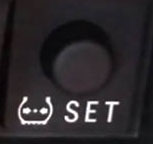Toyota Highlander is equipped with Tire Pressure Monitoring System (TPMS) for the purpose of warning the driver when one or more of the tires are significantly under-inflated, creating a potentially unsafe driving condition. In this article we discuss the reasons for the amber colored TPMS warning light in Highlander, and how you can reset it.

The TPMS warning light illuminates in Toyota Highlander when air pressure is low in one or more of the tires, battery has depleted in a pressure sensor, TPMS receiver module has malfunctioned, or a pressure sensor has been damaged.
Low tire pressure
When the amber colored TPMS warning light  turns on in your Highlander, stop your vehicle when it is safe to do so and check tire pressure on all the wheels, including the spare wheel (if your vehicle has one). Driving on a significantly under-inflated tire causes the tire to overheat and can lead to tire failure.
turns on in your Highlander, stop your vehicle when it is safe to do so and check tire pressure on all the wheels, including the spare wheel (if your vehicle has one). Driving on a significantly under-inflated tire causes the tire to overheat and can lead to tire failure.

Reinflate the tires
Reinflate all the tires of your Highlander to the manufacturer specified air pressure, which is mentioned on the vehicle placard or tire inflation pressure label usually located on the B-pillar or the edge of the driver door. If you can’t find the label, check the size of your tire which is mentioned on the sidewall of the tire, and match it to the tire pressure information shown below. These are official cold tire pressure values for Highlander from Toyota.
- 235/65R18 106V: 36 psi (250 kPa, 2.5 bar) – 4th gen
- 235/55R20 102V: 36 psi (250 kPa, 2.5 bar) – 4th gen
- 245/60R18 105T: 36 psi (250 kPa, 2.5 bar) – 3rd gen
- P245/60R18 104T: 36 psi (250 kPa, 2.5 bar) – 3rd gen
- 245/55R19 103T: 36 psi (250 kPa, 2.5 bar) – 3rd gen
- P245/65R17 105S: 30 psi (210 kPa, bar) – 2nd gen
- P245/55R19 103S: 30 psi (210 kPa, bar) – 2nd gen
- T165/90D18 (spare): 60 psi (420 kPa, 4.2 bar)

Resetting the TPMS warning light
After you have inflated all the tires to the correct air pressure, the TPMS warning light should turn off automatically after driving for a few miles. Toyota Highlander uses the direct method for monitoring tire pressure, which means a pressure sensor actively records the internal pressure and air temperature of the tire on each wheel. If the warning light doesn’t turn off you should perform a reset procedure.
The tire pressure warning system must be initialized in the following circumstances:
- When the tire inflation pressure is changed such as when changing traveling speed.
- When the tire inflation pressure is changed such as when the tire size is changed.
- When rotating the tires.
- After registering the ID codes.
When the tire pressure warning system is initialized, the current tire inflation pressure is set as the benchmark pressure.
TPMS reset in 4th gen Highlander (MY 2020, 2021, 2022, 2023)
- Turn on the vehicle.
- Using the steering wheel controls, navigate to Vehicle Settings in the instrument cluster display.
- Select TPWS (Tire Pressure Warning System).

- Select Set Pressure.

- Press and hold the OK button until confirmation message appears.
“Setting Tire Pressure Warning System” will be displayed on the multi-information display and the tire pressure warning light will blink 3 times. When the message disappears, initialization is complete.
A message is displayed on the multi-information display. Also, “–” is displayed for inflation pressure of each tire on the multi-information display while the tire pressure warning system determines the position.
Drive the vehicle at approximately 25 mph (40 km/h) or more for approximately 10 to 30 minutes until the inflation pressure of each tire is displayed on the multi-information display.
When initialization is complete, the inflation pressure of each tire will be displayed on the multi-information display.

Even if the vehicle is not driven at approximately 25 mph (40 km/h) or more, initialization can be completed by driving for a long time. However, if initialization does not complete after driving for 1 hour or more, park the vehicle in a safe place for approximately 20 minutes and then drive the vehicle again.
TPMS reset in 1st, 2nd, and 3rd gen Highlander (MY 2001 to 2019)
- Park the vehicle in a safe place and turn the engine switch to the “LOCK” position (vehicles without a smart key system) or off (vehicles with a smart key system).
Note: Initialization cannot be performed while the vehicle is moving. - Adjust the tire inflation pressure to the specified cold tire inflation pressure level.
Note: Make sure to adjust the tire pressure to the specified cold tire inflation pressure level. The tire pressure warning system will operate based on this pressure level. - Turn the engine switch to the “ON” position (vehicles without a smart key system) or IGNITION ON mode (vehicles with a smart key system).
- Press and hold the tire pressure warning reset switch (labeled SET) under the steering wheel until the tire pressure warning light blinks slowly 3 times.

- Vehicles without a smart key system: Wait for a few minutes with the engine switch in the “ON” position and then turn the engine switch to the “ACC” or “LOCK” position.
Vehicles with a smart key system: Wait for a few minutes with the engine switch in IGNITION ON mode and then turn the engine switch off.
Video Demonstration (3rd gen)
If the low tire pressure light does not turn off automatically after reinflating the tires in your Highlander, increase the tire pressure by 5 psi on top of the factory recommended value, and drive your vehicle for at least 10 miles (16 km). After the TPMS warning light turns off, and the vehicle has been parked for a few hours, reduce the tire pressure to the factory recommended value.
Chilly weather can turn on low tire pressure light in Highlander
Cold weather is one of the most common cause for low tire pressure warning light in Toyota Highlander. When analyzing WheelsJoint’s statistical data, it has been observed that there is sharp rise in the number of searches for TPMS warning light causes at the start of every winter season, about three times higher as compared to mid summer season.

The air, like most other substances, expands when heated and contracts when cooled. So when the weather gets colder, the tire pressure decreases, which could trigger TPMS warning light in Highlander. The tire pressure will vary with temperature by about 1 psi (7 kPa) for every 12°F (6.5°C).

Inflate tires when cold
Tire pressure in Highlander should always be set based on cold inflation tire pressure. This is defined as the tire pressure after the vehicle has not been driven for at least three hours, or driven less than 1 mile (1.6 km) after a three-hour period.
Do not adjust tire pressure when hot
The tires on your Highlander can get around 50 degrees hotter than the outside temperature when you’re driving, which increases the tire pressure by about 4 psi – this is normal and there should be no adjustment for this increased pressure.
Does altitude affect tire pressure?
Yes, altitude can change tire pressure values, but it is negligible and not a cause for concern. If you drive your Highlander from sea level to Mount Evans Scenic Byway in Colorado which is the highest paved road in North America at the altitude of 14,130 feet (4,307 m), the tire pressure should theoretically increase by approximately 6 psi. But, the decrease in ambient temperature at higher elevation contracts the air in tires and compensates for any altitude pressure changes.
Is it safe to drive Highlander with low tire pressure?
The driving characteristics of Highlander change even if the air pressure is 5 psi less than manufacturer’s recommended value: the braking distance can be longer, cornering worse, and at particularly high speeds there is even a risk that the tire will burst. Low tire pressure also increases tire wear, and the higher rolling resistance of the tire means higher fuel consumption. So it is recommended to reinflate the tires to the correct pressure as soon as possible.
Dead battery in a tire pressure sensor
Each tire pressure sensor in Highlander is powered by a built-in lithium-ion battery. When the battery is depleted, the sensor stops transmitting tire pressure information to the receiver module. When this happens, the TPMS warning light will flash every time the engine is started, and will remain illuminated until you turn off the vehicle.

How long do the pressure sensor batteries last?
The tire pressure sensor batteries usually last anywhere from 5 to 10 years in Highlander. When the battery is depleted, you must replace the sensor itself, as the battery is sealed into the sensor unit and is non-replaceable.
Identifying a faulty pressure sensor
The most reliable method for detecting a faulty tire pressure sensor or a sensor with dead battery is by testing each sensor with a scan tool. For example, MaxiTPMS TS408 is commonly used for diagnosing and programming tire pressure sensors. A sensor that is not detectable by the scanner is most likely defective and should be replaced with a new one.

If you don’t want to spend over a hundred bucks on a scanner, then head over to any reputable tire shop and perform a TPMS diagnostic scan of your Highlander. Some shops like Discount Tire and Pep Boys offer free of charge TPMS diagnostic services.
Installed new tires?
If a pressure sensor stopped responding after you installed new tires on your Highlander, it is possible the sensor got damaged during tire installation. These sensors are quite sensitive, and can be easily damaged if utmost care is not taken while changing tires.
Toyota Highlander TPMS user guide
Each tire, including the spare (if provided), should be checked monthly when cold and inflated to the inflation pressure recommended by the vehicle manufacturer on the vehicle placard or tire inflation pressure label (tire and load information label). (If your vehicle has tires of a different size than the size indicated on the vehicle placard or tire inflation pressure label [tire and load information label], you should determine the proper tire inflation pressure for those tires.)
As an added safety feature, your vehicle has been equipped with a tire pressure monitoring system (TPMS-tire pressure warning system) that illuminates a low tire pressure telltale (tire pressure warning light) when one or more of your tires is significantly under-inflated. Accordingly, when the low tire pressure telltale (tire pressure warning light) illuminates, you should stop and check your tires as soon as possible, and inflate them to the proper pressure. Driving on a significantly under-inflated tire causes the tire to overheat and can lead to tire failure. Under-inflation also reduces fuel efficiency and tire tread life, and may affect the vehicle’s handling and stopping ability.
WARNING: Please note that the TPMS (tire pressure warning system) is not a substitute for proper tire maintenance, and it is the driver’s responsibility to maintain correct tire pressure, even if under-inflation has not reached the level to trigger illumination of the TPMS low tire pressure telltale (tire pressure warning light).
TPMS Malfunction indicator
Your vehicle has also been equipped with a TPMS (tire pressure warning system) malfunction indicator to indicate when the system is not operating properly. The TPMS (tire pressure warning system) malfunction indicator is combined with the low tire pressure telltale (tire pressure warning light). When the system detects a malfunction, the telltale will flash for approximately one minute and then remain continuously illuminated. This sequence will continue upon subsequent vehicle start-ups as long as the malfunction exists. When the malfunction indicator is illuminated, the system may not be able to detect or signal low tire pressure as intended.
TPMS (tire pressure warning system) malfunctions may occur for a variety of reasons, including the installation of replacement or alternate tires or wheels on the vehicle that prevent the TPMS (tire pressure warning system) from functioning properly. Always check the TPMS (tire pressure warning system) malfunction telltale after replacing one or more tires or wheels on your vehicle to ensure that the replacement or alternate tires and wheels allow the TPMS (tire pressure warning system) to continue to function properly.
Note: To ensure the tire pressure warning system operates properly, do not install tires with different specifications or makers, as the tire pressure warning system may not operate properly.
Tire pressure display
You can view the individual tire pressure information in the instrument cluster display. It may take a few minutes to display the tire inflation pressure after the engine switch is turned to ON. It may also take a few minutes to display the tire inflation pressure after inflation pressure has been adjusted.

“—” may be displayed if the tire position information cannot be determined due to unfavorable radio wave conditions.
Tire inflation pressure changes with temperature. The displayed values may also be different from the values measured using a tire pressure gauge.
Video: Viewing tire pressure information
Repairing or replacing snow tires
Request repairs or replacement of snow tires from Toyota dealers or legitimate tire retailers. This is because the removal and attachment of snow tires affects the operation of the tire pressure warning valves and transmitters.
Fitting tire chains
The tire pressure warning valves and transmitters may not function correctly when tire chains are fitted.
Situations in which the tire pressure warning system may not operate properly
In the following cases, the tire pressure warning system may not operate properly.
- If non-genuine Toyota wheels are used.
- A tire has been replaced with a tire that is not an OE (Original Equipment) tire.
- A tire has been replaced with a tire that is not of the specified size.
- Tire chains, etc. are equipped.
- An auxiliary-supported run-flat tire is equipped.
- If a window tint that affects the radio wave signals is installed.
- If there is a lot of snow or ice on the vehicle, particularly around the wheels or wheel housings.
- If the tire inflation pressure is extremely higher than the specified level.
- If the spare tire is in a location subject to poor radio wave signal reception.
- If wheel without the tire pressure warning valve and transmitter is used.
- If the ID code on the tire pressure warning valves and transmitters is not registered in the tire pressure warning computer.
Performance may be affected in the following situations.
- Near a TV tower, electric power plant, gas station, radio station, large display, airport or other facility that generates strong radio waves or electrical noise.
- When carrying a portable radio, cellular phone, cordless phone or other wireless communication device
If tire position information is not correctly displayed due to the radio wave conditions, the display may be corrected by driving and changing the radio wave conditions.
When the vehicle is parked, the time taken for the warning to start or go off could be extended.
When tire inflation pressure declines rapidly for example when a tire has burst, the warning may not function.
Warning performance of the tire pressure warning system
The warning of the tire pressure warning system will change in accordance with the conditions under which it was initialized. For this reason, the system may give a warning even if the tire pressure does not reach a low enough level, or if the pressure is higher than the pressure that was adjusted to when the system was initialized.
Installing tire pressure warning valves and transmitters
When replacing tires or wheels, tire pressure warning valves and transmitters must also be installed.
When new tire pressure warning valves and transmitters are installed, new ID codes must be registered in the tire pressure warning computer and the tire pressure warning system must be initialized. Have tire pressure warning valves and transmitter ID codes registered by your Toyota dealer.
Replacing tires and wheels
If the ID code of the tire pressure warning valve and transmitter is not registered, the tire pressure warning system will not work properly. After driving for about 20 minutes, the tire pressure warning light blinks for 1 minute and stays on to indicate a system malfunction.
- When removing or fitting the wheels, tires or the tire pressure warning valves and transmitters, contact your Toyota dealer as the tire pressure warning valves and transmitters may be damaged if not handled correctly.
- Make sure to install the tire valve caps. If the tire valve caps are not installed, water could enter the tire pressure warning valves and the tire pressure warning valves could be bound.
- When replacing tire valve caps, do not use tire valve caps other than those specified. The cap may become stuck.
- To avoid damage to the tire pressure warning valves and transmitters: When a tire is repaired with liquid sealants, the tire pressure warning valve and transmitter may not operate properly. If a liquid sealant is used, contact your Toyota dealer or other qualified service shop as soon as possible. Make sure to replace the tire pressure warning valve and transmitter when replacing the tire.
When performing TPMS reset
Make sure to carry out initialization after adjusting the tire inflation pressure. Also, make sure the tires are cold before carrying out initialization or tire inflation pressure adjustment.
If you have accidentally turned the engine switch off during initialization, it is not necessary to restart the initialization again as initialization will restart automatically when the engine switch has been turned to ON for the next time.
If you accidentally restart the initialization when initialization is not necessary, adjust the tire inflation pressure to the specified level when the tires are cold, and conduct initialization again.
While the position of each tire is being determined and the inflation pressures are not being displayed on the multi-information display, if the inflation pressure of a tire drops, the tire pressure warning light will come on.
When initialization of the tire pressure warning system has failed
Initialization may take longer to complete if the vehicle is driven on an unpaved road. When performing initialization, drive on a paved road if possible. Depending on the driving environment and condition of the tires, initialization will be completed in approximately 10 to 30 minutes. If initialization is not complete after driving approximately 10 to 30 minutes, continue driving for a while.
If the inflation pressure of each tire is not displayed after driving for approximately 1 hour, perform the following procedure.
- Park the vehicle in a safe place for approximately 20 minutes. Then drive straight (with occasional left and right turns) at approximately 25 mph (40 km/h) or more for approximately 10 to 30 minutes
However, in the following situations, the tire inflation pressure will not be recorded and the system will not operate properly. Perform initialization again.
- If the vehicle is reversed during initialization, the data up to that point is reset, so perform the initialization procedure again from the beginning.
- When operating the tire pressure warning reset switch, the tire pressure warning light does not blink 3 times.
- After performing initialization, the tire pressure warning light blinks for 1 minute then stays on while driving.
Reset the entire system
If the low tire pressure warning light won’t turn off due to a glitch in the tire pressure monitoring system, it may be possible to reset the TPMS system by resetting all on-board computers in your Highlander. This method should only be considered as a last resort, when all else fails.

You can reboot all the on-board computers by disconnecting the main 12 volt battery for a few minutes. Remove the cable from the negative terminal of the battery first, then from the positive terminal. With the battery disconnected, press the horn button a few times and turn on the headlights to drain out all the residual electricity from the system. After about 15 minutes, reconnect the battery in reverse order: positive cable first, then negative cable.
Tire pressure keeps getting low
If the TPMS warning light turns on frequently in your Highlander, and the tire pressure is also decreasing after you have reinflated the tires, there may be an air leak. One or more of the tires may have been punctured by an external object, or the air may be leaking from a defective value stem.

Can I disable the TPMS system in Highlander?
No, the TPMS system is federally mandated, and cannot be disabled in Toyota Highlander. All vehicles must have a working tire pressure monitoring system to be legally compliant.
Use OBD2 scanner for diagnosis
Since Toyota Highlander is equipped with on-board diagnostics (OBD), a fault diagnosis can provide initial indications of where the malfunction is located. But when it comes to TPMS, a basic code reader will not suffice. You will need an advanced scanner to monitor TPMS data or read TPMS codes.

BlueDriver is a commonly used scanner by DIYers that can read TPMS codes for most vehicles and isn’t too expensive – costs about a hundred bucks. You can also clear the TPMS fault codes with this device which will turn off the warning light, but the light may come back on if the on-board diagnostic system detects a fault again.



my 2015 toyota highlander does not have a TPMS reset button as pictured in this article. can i still reset my TPMS?